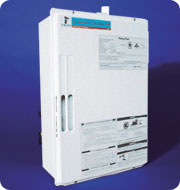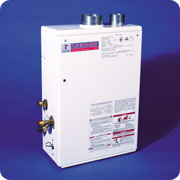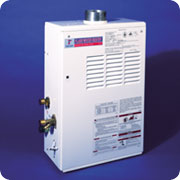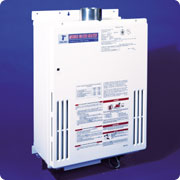|
Takagi offers the
highest flow rates and BTU out
put on the market today. |
| |
 |
 |
 |
 |
 |
Model
|
FLASH
T-K Jr.
|
FLASH
T-KD20
|
FLASH
T-K2
|
FLASH
T-K1S
|
MOBIUS
T-M1
|
BTU Max
(NG)
|
140,000
BTU
|
185,000
BTU
|
185,000
BTU
|
190,000
BTU
|
235,000
BTU
|
| BTU Min
(NG) |
19,500
BTU
|
20,000
BTU
|
20,000
BTU
|
15,000
BTU
|
25,000
BTU
|
| Flow
Rating |
0.75
- 5.8 GPM |
0.75
- 6.9 GPM |
0.75
- 6.9 GPM |
0.75
- 6.9 GPM |
0.75
- 9.6 GPM |
First
Hour
Rating
(DOE)
|
181
gallons/hour
3.0 gallons/minute
(77F
rising)
|
240
gallons/hour
4.0 gallons/minute
(77F
rising)
|
240
gallons/hour
4.0 gallons/minute
(77F
rising)
|
245
gallons/hour
4.1 gallons/minute
(77F
rising)
|
300
gallons/hour
5.0 gallons/minute
(77F
rising)
|
Net
Weight
|
30
lbs
|
60
lbs
|
60lbs.
|
46lbs.
|
70lbs.
|
Energy
Factor
|
NG
83
LP
84
|
NG
84
LP
85
|
NG
84
LP
85
|
NG
83
LP
84
|
NG
82
LP
84
|
Dimensions
|
H20.0"
W14.0" D6.0"
|
H24.0"
W18.0" D9.0"
|
H24.0"
W18.0" D9.0"
|
H24.5"
W16.5" D8.3"
|
H24.0"
W18.0" D9.0"
|
Thermal
Efficiency
|
Natural:
83.0%
LP: 84.0 %
|
Natural:
85.0%
LP: 86.0 %
|
Natural:
85.0%
LP: 86.0 %
|
Natural:
83.0%
LP: 84.0 %
|
Natural:
82.3 %
LP: 84.7 %
|
|
Demand (Tankless) Water Heaters
Water heating accounts for 20%
or more of an average household's annual
energy expenditures. The yearly operating
costs for conventional gas or electric
storage tank water heaters average $200
or $450, respectively. Storage tank-type
water heaters raise and maintain the
water temperature to the temperature
setting on the tank (usually between (120
-140 F) (49 -60 C). The heater does this
even if no hot water is drawn from the
tank (and cold water enters the tank).
This is due to "standby
losses": the heat conducted and
radiated from the walls of the tank-and
in gas-fired water heaters-through the
flue pipe. These standby losses represent
10% to 20% of a household's annual water
heating costs. One way to reduce this
expenditure is to use a demand (also
called "tankless" or
"instantaneous") water heater.
Demand water heaters are common in Japan
and Europe. They began appearing in the
United States about 25 years ago. Unlike
"conventional" tank water
heater, tankless water heaters heat water
only as it is used, or on demand. A
tankless unit has a heating device that
is activated by the flow of water when a
hot water valve is opened. Once
activated, the heater delivers a constant
supply of hot water. The output of the
heater, however, limits the rate of the
heated water flow.
Gas and Electric
Demand Water Heaters
Demand water heaters are
available in propane (LP), natural gas,
or electric models. They come in a
variety of sizes for different
applications, such as a whole-house water
heater, a hot water source for a remote
bathroom or hot tub, or as a boiler to
provide hot water for a home heating
system. They can also be used as a
booster for dishwashers, washing
machines, and a solar or wood-fired
domestic hot water system.
You
may install a demand water heater
centrally or at the point of use,
depending on the amount of hot water
required. For example, you can use a
small electric unit as a booster for a
remote bathroom or laundry. These are
usually installed in a closet or
underneath a sink. The largest gas units,
which may provide all the hot water needs
of a household, are installed centrally.
Gas-fired models have a higher hot water
output than electric models. As with many
tank water heaters, even the largest
whole house tankless gas models cannot
supply enough hot water for simultaneous,
multiple uses of hot water (i.e., showers
and laundry). Large users of hot water,
such as the clothes washer and
dishwasher, need to be operated
separately. Alternatively, separate
demand water heaters can be installed to
meet individual hot water loads, or two
or more water heaters can be connected in
parallel for simultaneous demands for hot
water. Some manufacturers of tankless
heaters claim that their product can
match the performance of any 40 gallon
(151 liter) tank heater.
Selecting a Demand
Water Heater
Select a demand water heater
based on the maximum amount of hot water
to meet your peak demand. Use the
following assumptions on water flow for
various appliances to find the size of
unit that is right for your purposes:
Fau CETs: 0.75
gallons (2.84 liters) to 2.5 gallons
(9.46 liters) per minute.
Low-flow
showerheads: 1.2 gallons (4.54
liters) to 2 gallons (7.57 liters) per
minute.
Older standard
shower heads: 2.5 gallons (9.46
liters) to 3.5 gallons (13.25 liters) per
minute.
Clothes washers and
dishwashers: 1 gallon (3.79
liters) to 2 gallons (7.57 liters) per
minute.
Unless you know otherwise, assume that
the incoming potable water temperature is
50(F (10(C). You will want your water
heated to 120(F (49(C) for most uses, or
140 F (60 C) for dishwashers without
internal heaters. To determine how much
of a temperature rise you need, subtract
the incoming water temperature from the
desired output temperature. In this
example, the needed rise is 70(F (21(C).
List the number of hot water devices you
expect to have open at any one time, and
add up their flow rates. This is the
desired flow rate for the demand water
heater. Select a manufacturer that makes
such a unit. Most demand water heaters
are rated for a variety of inlet water
temperatures. Choose the model of water
heater that is closest to your needs.
As
an example, assume the following
conditions: One hot water fau CETopen
with a flow rate of 0.75 gallons (2.84
liters) per minute. One person bathing
using a shower head with a flow rate of
2.5 gallons (9.46 liters) per minute. Add
the two flow rates together. If the inlet
water temperature is 50 F (10 C), the
needed flow rate through the demand water
heater would need to be no greater than
3.25 gallons (12.3 liters) per minute.
Faster flow rates or cooler inlet
temperatures will reduce the water
temperature at the most distant fau CET.
Using low-flow showerheads and
water-conserving fau CETs are a good idea
with demand water heaters.
Some types of tankless water heaters are
thermostatically controlled. They can
vary their output temperature according
to the water flow rate and the inlet
water temperature. This is useful when
using a solar water heater for
pre-heating the inlet water. If, using
the above example, you connect this same
unit to the outlet of a solar system, it
only has to raise the water temperature a
few degrees more, if at all, depending on
the amount of solar gain that day.
Cost
Demand
water heaters cost more than conventional
storage tank-type units. Small
point-of-use heaters that deliver 1
gallon (3.8 liters) to 2 gallons (7.6
liters) per minute sell for about $200.
Larger gas-fired tankless units that
deliver 3 gallons (11.4 liters) to 5
gallons (19 liters) per minute cost
$550-$1000.
The
appeal of demand water heaters is not
only the elimination of the standby
losses and the resulting lower operating
costs, but also the fact that the heater
delivers hot water continuously. Gas
models with a standing (constantly
burning) pilot light, however, offset the
savings achieved by the elimination of
standby losses with the energy consumed
by the pilot light. Moreover, much of the
heat produced by the pilot light of a
tank-type water heater heats the water in
the tank; most of this heat is not used
productively in a demand water heater.
The exact cost of operating the pilot
light will depend on the design of the
heater and price of gas, but could range
from $12 to $20 per year. Ask the
manufacturer of the unit how much gas the
pilot light uses for the models you
consider. It is a common practice in
Europe to turn off the pilot light when
the unit is not in use.
An
alternative to the standing pilot light
is an intermittent ignition device (IID).
This resembles the spark ignition device
on some gas kitchen ranges and ovens. Not
all demand water heaters have this
electrical device. You should check with
the manufacturer for models that have
this feature.
Life Expectancy
Most tankless models have a
life expectancy of more than 20 years. In
contrast, storage tank water heaters last
10 to 15 years. Most tankless models have
easily replaceable parts that can extend
their life by many years more.
|







